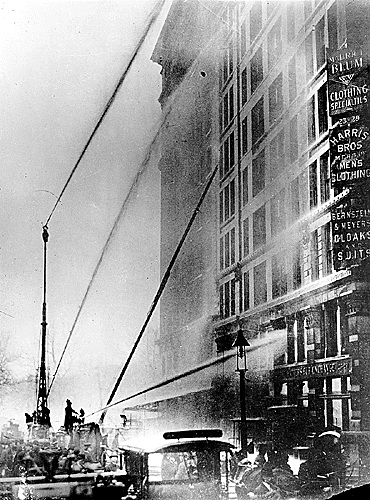This month marks the 100th Anniversary of one of the worst workplace disasters in American history. On March 25, 1911, 146 factory workers were killed in a horrific fire in New York City’s Triangle Waistcoat Factory. Those who died were working at sewing machines on the 9th floor of the Asch Building. The Triangle Factory was one of the city’s most successful, but the workers, mostly young women, worked long hours in dangerous conditions. The fire began near closing time on a Saturday, sparked by a match or cigarette dropped into a basket of scraps. It spread quickly, giving the workers little time to respond. A fire escape collapsed, a door was locked (a deterrent to worker’s leaving without being searched), and the elevator stopped running. The fire department arrived, but their ladders were not long enough to reach the trapped workers. Some died when they tumbled down the elevator shaft, some jumped to their deaths, and others died on the factory floor.

This terrible event, which many watched helpless from the street, sparked a rush of public support for new legislation that would protect workers. One in ten New Yorkers attended a massive funeral for the victims on April 5 and many called for change. Not long before the Triangle fire, the workers had participated in a massive strike with other garment workers across the city. While some of the workers’ demands were successful, the Triangle workers were unable to convince their owners to allow a union or change safety conditions on the floor. The workers knew that their factory, despite its windows and high ceilings, was unsafe. During the strike, there were those who were unsympathetic to the worker’s cause, but after March 25, public opinion had shifted and reform was possible.
It can be easy to think about history in terms of numbers, years, and titles, but each of the workers who were killed in the Triangle fire had a story, a history, of their own. Many were Jewish and Italian immigrants, new to America, who worked long hours to support their families. Many of those who died were teenage girls- the youngest was only fourteen.
If you want to learn more about these workers, the fire, and the reform that came afterwards, you will find many resources available at IU East Campus Library.
A few databases to get you started:
EBSCOHost Newspaper Source –Find newspaper and magazine articles that discuss the fire and its impact.
Daily Life Through History- Learn what life was like for workers during the time of the Triangle Fire.
One example: “Accidents in the Workplace”
CWI: Contemporary Women’s Issues – Find information about women’s history and female reformers.
PROQUEST: New York Times-Search for newspaper articles about the fire
PROQUEST: Dissertations and Theses-Explore papers that discuss the importance of the fire in American history.
Print Books:
Triangle: The Fire that Changed America by David Von Drehle. New York: Atlantic Monthly Press, 2003.
America’s Working Women by Rosalyn Fraad Baxadnall, Linda Gordon and Susan Reverby. New York: Random House, 1976.
Juvenile Books:
Ashes of Roses by Mary Jane Auch. New York: Henry Holt and Company, 2004.
Fire at the Triangle Factory by Holly Littlefield, Illustrated by Mary O’Keefe Young. Minneapolis: Carolhoda Books, 1996.
You can also order books and journal articles about this topic through interlibrary loan.
A recent American Experience Documentary entitled “Triangle Fire” is available on the PBS website (www.pbs.org). You will also find additional information, including stories from the families of survivors.
If you have any questions about library resources, feel free to call (765-973-8311), email (iueref@iue.edu), or stop by the library. We’re always happy to help!

